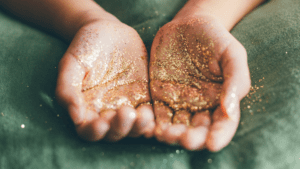
Germs are very very small, so small they are invisible to our eyes. We have many germs on our hands all the time. They like to live in the invisible layer of oil on our hands, and they particularly like to hide in skin creases and under our nails. In fact, there are many thousands and thousands of germs on your hands right now!
Germs spread in lots of different ways. Some of them travel in saliva through the air, which is why you should cover your mouth when you sneeze and cough. But even then you still get the germs on your hands.
The good news is that we can use science to help protect us from germs!
Explore the power of soap with the fun and glittery experiment! Just gather the materials listed at the right, and follow the instructions below!
Required Materials
- baby oil (any skin safe oil will work)
- glitter
- soap
- water
- cup
Step-By-Step Instructions
Step 1
Have everyone participating in the experiment rub baby oil on their hands.
Step 2
Ask one person sprinkle glitter onto their hands. The glitter represents the germs that cover our hands when we sneeze, cough, or wipe our nose!
Step 3
Have the person with the glitter shake hands with everyone else.
What happens to the glitter?
Step 4
Ask everyone with glitter on their hands to pick up the cup or another item near by.
What happens to the glitter?
Step 5
Have everyone try to was their glittery hands in warm water without soap.
Did the glitter go away?
Step 6
Have everyone wash their hands again, this time with soap for 20 seconds.
Did the glitter go away this time?
Many germs love to move from person-to-person by personal contact. If you had washed your hands thoroughly right after you spread the glitter onto them, the glitter wouldn’t have been around to get spread!
Soap doesn’t kill germs on our hands, it removes them.
According to, LiveScience.com, Germs stick to the oils and grease on our hands (sounds yucky, but it’s totally normal). Water alone won’t remove much of the germs on our hands because water and oil don’t like each other, so they won’t mix. But soap likes both water and oil. That’s because soap molecules are a type of surfactant, which means they have one end that’s water loving, or hydrophilic, and one end that’s oil loving, or hydrophobic.
When you wash your hands with soap, the soap molecules act as a mediator between the water and oil molecules, and bind with both of them at the same time. Then when you rinse everything off, the soap carries away the germs with the water.